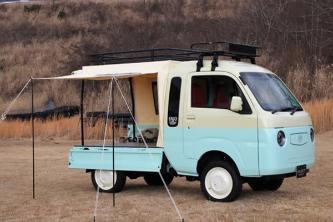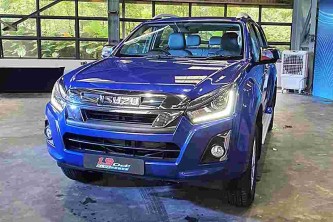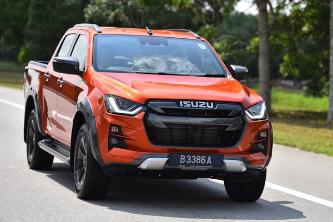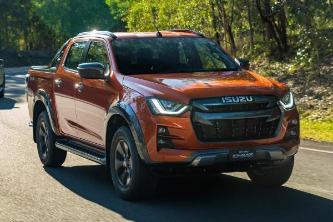isuzu camper
Artikel Terkait isuzu camper

All-new Isuzu D-Max launched in Thailand
Isuzu Thailand has just taken the wraps off the all-new D-Max, just a week after teasing the all-new
Scoop: All-new 2021 Isuzu MU-X patent images leaked!
The Isuzu MU-X, the D-Maxs SUV cousin has been in production since 2013 with a facelift introduced in
Launching in Malaysia in April, 2021 Isuzu D-Max priced from RM 89K
Isuzu Malaysia has announced that bookings of the all-new 2021 Isuzu D-Max will open today and the brand-new
In Brief: New Isuzu D-Max 2019, now with 1.9L BluePower Ddi engine
First launched in 2011, the current generation Isuzu D-Max is the oldest pick-up truck in the segment
Spied in Malaysia: All-new third gen 2022 Isuzu D-Max
The all-new third generation Isuzu D-Max has been spotted in Malaysia.
Up to 6 months deferred instalments for a new Isuzu D-Max
Isuzu Malaysia is paving the path to normalcy for potential Isuzu D-Max customers by offering a moratorium
Spied: All-new 2021 Isuzu D-Max spotted at Westport, confirms CBU status
The all-new 2021 Isuzu D-Max has been spotted again in Malaysia.
When Isuzu made sports cars – 117 Coupe, Piazza, Gemini
Isuzu is currently the worlds biggest manufacturer of diesel engines.
All-new third generation Isuzu D-Max won’t be in Malaysia until 2022
Several months ago, the all-new third generation 2020 Isuzu D-Max made its global at the 2019 Thailand
Kitted-up 2020 Isuzu D-Max revealed, but not for us yet
marque showcased dressed up versions of their cars.Isuzu turned up the heat at their booth with modified Isuzu
Current Isuzu D-Max in Malaysia selling out fast, all-new model coming sooner than expected?
Back in early-2020, we reported that the all-new RG-generation Isuzu D-Max won’t be arriving in
Toyota is now best friends with Isuzu, takes 8% share, JV for next-gen connected trucks
Isuzu FL-IR concept is an autonomous driving truckToyota and its commercial trucks subsidiary Hino have
2020 Isuzu D-Max is the safest pick-up truck in ASEAN
The 2020 Isuzu D-Max has always been known for being a robust and reliable pick-up truck.
The tent on this Mitsubishi Triton camper literally blows
a day in the great outdoors, Mitsubishi Motors Germany has just the perfect solution by offering a camper
The Blue Monster Isuzu D-Max survived the Borneo Safari
Isuzu’s new pup proved its worth in the gruelling Borneo Safari challenge and even gets given the
All-new Isuzu D-Max has more safety equipment than many sedans!
Last week, Isuzu Thailand took the covers off the all-new D-Max.
Isuzu Buy and Win campaign concludes with two lucky winners
The Isuzu D-Max Buy and Win contest that ran between April and June 2019 saw Ghanie Entalang of Sebauh
All-new 2021 Isuzu D-Max – Malaysian-spec to get ACC with stop and go
Set to be launched in Malaysia before the end of April, Isuzu Malaysia has revealed preliminary specifications
All-new 2021 Isuzu D-Max to be launched in Malaysia ahead of Mazda BT-50
It looks like the Isuzu D-Max is not at risk of being upstaged by its sister-car the Mazda BT-50, as
Special edition 2020 Isuzu D-Max previewed, to fight new Toyota Hilux facelift
Not one to take the Toyota Hilux’s threat lying down, Isuzu aired teasers of its upcoming Isuzu
Review Post isuzu camper
ISUZU 4X4 EBACAMP PICKUP CAMPER - https://t.co/D1RVrZiJDl https://t.co/eoYn2ZwF3t
6038012922 1992 Isuzu Elf Camper https://t.co/WSVwH4Gbt1
Isuzu D-MAX with a camper conversion and French EU plates in OKC. This is a very good truck/camper. https://t.co/S2f1fZoPnI
That is a cool micro RV. === #motorhomes #motorhome #RV #RVs #tinyhomes #tinyhouses === RHD 1992 Isuzu Fargo Diesel Camper JDM - rvs - by dealer - vehicle... https://t.co/iTLA6GkxEt https://t.co/tuh38AAMw3
These people load up their smart car in the back of an Isuzu that also hauls their camper https://t.co/FDj1RAJLHW
Isuzu Faster Rodeo Camper (1990) #vehicle #Isuzu #Water https://t.co/a06rGl11xf Did someone say perfect 4-season adventuremobile? 1990 Isuzu Rodeo Camper. 4WD, https://t.co/v6tTHcUqdw
Tiny Isuzu Fargo Camper Packs Lots Of Amenities Into Small Space https://t.co/aep8dhy5vW https://t.co/YFLBQJYW03
THIS… is a 1995 Isuzu Fargo 4x4 Camper! That’s right: - Kitchen (with sink, 2-burner cooktop, and refrigerator) - Bathroom - 4-person convertible dinette - Cabover bed - Solar power - 4WD - 5-speed manual Don’t miss this JDM camper, live on Cars & Bids! https://t.co/TgYO5OLLx2 https://t.co/jRYd5WPyrB
RARE JDM RHD 1992 Isuzu Elf Diesel Camper (Hudson NH) $17500 - https://t.co/sz6KAo0NLv https://t.co/yr5g8UwFwP
This Isuzu Fargo 4x4 Camper Is An Old JDM RV You Can Actually Live With https://t.co/yADwMgLfWz https://t.co/LN9KUDe7MT
Review Q&A isuzu camper
In which Indian cars can I keep a motorcycle on the back side?
The Mahindra Scorpio Getaway, Tata Xenon, and Isuzu D Max are popular, practical options. Mahindra Bolero Camper is another option and so is the Mahindra Pikup.
Are there any vans that are similar to Westfalias but aren’t VWs?
Take your pick, in many countries either Japanese or Euro vans are commonly converted into ‘campers- smaller ones like the Toyota Hiace, Mitsubishi Express and the like are commonly used For those wanting a larger one, Mercedes Sprinter and the Ford Transit are popular- either with a ‘poptop’ or more common in the larger vans is using the ‘hiroof’ versions Also popular in some areas are 4wd based ones- often using the Landcruiser, Hilux, BT50/Ranger or Isuzu chassis…
How many kilometres should a turbo diesel engine last?
I owned an Isuzu Jackaro/Monterey/Bigfoot with a 3.1 litre turbo diesel. I sold it at 380,000 km not because it was tired, but because we had bought a larger caravan which was right in its tow-weight limit - it had been very happy towing our smaller caravan around for some years. The next owners used it to tow their small camper van around and they had it for more than two more years. They said they were very happy with it. So 400,000–500,000 is quite normal, even when you work the engine hard. In fact diesels work best when they are WORKING rather than leaving along.
Can we Isuzu D-Max S-Cab with whiteboard registration? What is its mileage?
The registration of Isuzu D-Max S-Cab for personal use is a grey issue in India. Regulations may vary from state to state and even between RTO offices (depending on the person designated as registering authority, unfortunately). There have been instances where owners had approached the courts for getting their pickup trucks registered for personal use. This happens mostly with Bolero Camper, Tata Xenon, and D-Max. In a landmark judgement (Cherian vs Transport Commissioner), the Kerala High Court had ruled that such vehicles can be registered for personal use if the owner intends to use it for such non-commercial uses. However, in the latest case of Hassan Koya v/s Transport Commissioner, the High Court ruled that the classification made by the manufacturer would be applicable for registration, irrespective of the intended use by the owner. Quite interestingly, the brochure, , of BS6 Isuzu D-Max S-Cab categorically disclaims that “The ISUZU D-MAX S-CAB vehicle can only be registered as ‘Commercial Vehicle’ in India”. Hence I guess it will be really difficult to get it registered with a white board now.
Which van is best for converting into a motorhome?
IMHO??? Any FWD diesel highroof, long wheelbase van- my preference is for turboed diesels The Mercedes Sprinter is one of the top in my estimation, and the newer Ford Transits are pretty good too (earlier ie pre 2014 had some issues, ignoring the 1970’s/80’s ones here) For bigger ones, I’d go the Japanese light truck market- Hino, Isuzu, Mitsubishi in order of preference especially if you can get a ex refridgerated pantech body as the basis for a camper conversion, the insulation makes heating and cooling it far easier
Which is the best lifestyle truck in India, and why?
It depends upon your mindset basically. If you are into looks, then the list goes with Isuzu D-Max following which is Tata Xenon and lastly Mahindra Bolero Camper. Reverse the list if you want less of headache (relating to serviceability, ease of finding parts, cheaper service) and more of build quality. All three of them have almost same price tag.
Is driving a diesel car more economical than driving a petrol car when considering all operating costs?
My previous diesel SUV (Isuzu Monterey/Bigfoot/jackaroo) had 370,000 km when I sold it, and I only sold it because we bought a bigger caravan which was right at its towing limits. The next owners have been very happy with it as a general car and occasional tow vehicle for their small camper trailer. I had to get the rear diff and rear wheel bearings changed at about 330,000 km but that could have happened to any vehicle which towed a lot. That was the only major repair during the years we had that vehicle. I now have a 3 litre Isuzu Dmax pickup truck and it's done 140,000 km in the 5 years I've had it. Most of that has been towing the larger 2.5 tonne caravan all over Australia. Unfortunately, I've had to replace the windscreen wiper blades, and the fan belts. Horrible expense yes? It gets the same fuel economy as my 50 year old VW beetle which is one third the weight and has an engine half the size. That vehicle has had one engine rebuild in its 400,000 km with another engine rebuild needed right now. I'll save some money by doing that myself, as per the last time. Pickup trucks (called Utes or Utility vehicles here in Australia) are almost all diesels, from 2.2 litres to 3.2 litres. That includes Toyota's, Nissan's, Mussos, Mahindrahs, Mitsubishi's, Isuzu's and about 10 other brands. Hardly a petrol (gasoline) version to be seen. And they are the single most popular type of vehicle sold in Australia and have been for the last 4–5 years. Reliability is paramount in them. They are the primary type of vehicle used "out in the bush" where diesel is available everywhere and petrol is occasionally in short supply. 500,000 km is about the minimum normal for the life for them. If repairs are required to a Diesel engine it CAN be expensive, especially for the very high pressure fuel injection pump, which is a precision piece of machinery. But repairs to diesels are generally few and far between if you feed them clean fuel and change the oil at the recommended intervals. And I'm speaking from the point of view of having owned three diesel tow trucks, two diesel SUVs and driving heavy trucks for many years. So owning a diesel is not going to cost you much more (it any more) in repairs than owning a gasoline powered vehicle.
What's the coldest you've ever been while camping?
-17F (-22C), yes that’s 17 degrees below zero Farenheit while camping on a hunting trip in the mountains near Wetmore, Colorado. We had the hunt planned for a long time, and the temperature in the town of Westcliffe (closest forecast available) was forecast to only go down to -5F. I had pulled an Apache Mesa II hard-sided pop-up camper down from Denver with my ’86 Isuzu Trooper II. When we arrived at the turn to go off-highway to our camp site, we had to actually tow the trailer around the Chevy Blazer K5 and utility trailer belonging to another member of our group that had become stuck in about 3′ of drifted snow on the logging road upon which we were traveling. He had to unload his 6X6 Argo ATV to continue to the campsite. My South American market Trooper II came with limited-slip differentials in both the front and the rear, and I had lifted the truck 4″ to clear the 35″ mud and snow tires, and installed a 6″ lift kit on the camper for off-highway adventures. Several times I had drifted snow coming over the hood, and had to get out and clear the grille. When we set up camp in the mid-afternoon the temperature had fallen from the 35F of Denver, to 22F in the small valley in which we were camping. We set up the camper, and tuned the 20K BTU propane furnace inside to maximum heating. We had brought 4 full bottles of propane for this planned 3 day/2 night trip, because the camper was known to be drafty with the flip-up hard-side panels that generally left 3–4 mm gap along the edges, which we tried to cover with duct-tape once it was set up. It was still drafty, though. We went out scouting about two hours before sunset, making sure the deer were still bedding and browsing in the same areas they had been on our two previous scouting trips. They were still in the same areas, at about 8700 ft in elevation. By the time we had made a campfire, organized our gear, and had dinner, the indoor/outdoor thermometer in the camper was showing 11F outside and 49F inside. We sat inside enjoying the relative warmth, and the three of us went to bed around 8:30 pm looking forward to getting up at 4 a.m. for hunting. At 4 a.m., even with the furnace running at maximum all night, the air temperature in the camper was down to 35F, and it was -17F outside. ,17 below zero! My boots, which had had some snow on them when I came in for the night, were frozen to the linoleum floor of the camper by the door. After lighting all three stove burners and the oven, we managed to get the interior temperature up to 52F, and rather than peeing outside, we decided to use the cassette toilet in the camper. But cold or no, we all went out to our selected hunting spots, and by 9 a.m., all three of us had filled our Mule Deer tags, and rather than hang out, decided to load up and head back to civilization. When we left at around 11:30 a.m., the outside temperature had risen to a balmy 8F. Never again will this Florida boy hunt in sub-freezing temperatures unless my life depends on it.
What is the best, most reliable early 2000s diesel pickup? I know nothing about the types of diesel. I need to tow a camper long term, cross country. I’m looking for at least a 12,000lb tow capacity.
How early is early? Ford discontinued its 7.3 Powerstroke International Harvester based Diesel engine mid 2003 due to emissions. They went to the 6.0 Powerstroke, lots of issues but very dependable if they weren’t tuned and adult owned. I’m a GM guy and I love the 6.6 Duramax (Isuzu engineered) but I love the Ford/International diesels of the late 90’s early 00’s. You can’t go wrong with an inline 6 Cummins 24 Valve, so much torque but the rest is the truck is Mopar junk. If I’m you I want a 99–03 Ford with a 7.3 turbo Diesel, don’t rule out the Excursion either. Buy it and enjoy the days before the tree huggers gained power.
Which is the most comfortable car for long distance travel?
I don’t know if, ,Muzaffar Ali was joking but ‘airplane’ is the best vehicle for a trip over 1,000 miles, especially for a single person. An airplane flight should be the quickest and cheapest. A high speed train can be better and even quicker but usually is more costly. If you are taking a road trip then you must consider the return journey as well. First of all you vehicle must be completely reliable and handle expertly. Fatigue is a major danger on long journeys so not only do you need a comfortable seat, but a seat with support and a vehicle that drives effortlessly. Accomodation is a big issue. There are two approaches. You can zoom across in a sporty number and pay for established accomodation and dining or you can self-cater. Whether you self-cater with camping and cooler or with an RV the trip is going to be slower and require much more preparation. The best vehicle in Europe for doing a road trip is a VW Kepler (VW Californian or Westfalia). Where roads are more open then I’d go for the larger Fiat Ducato style RV. In Australia a converted Mercedes Sprinter is a good option. Personally I drive a Isuzu Mux that allows me to sleep in the rear with the seats folded down if I need to travel a long trip quickly. Normally I tow a camper trailor and take my time. If I was in the U.S.A. then I would probably like to hire a corvette and zoom between motels (that is if the $US wasn’t so prohibitive a.t.m.)
 Beranda
Beranda 


